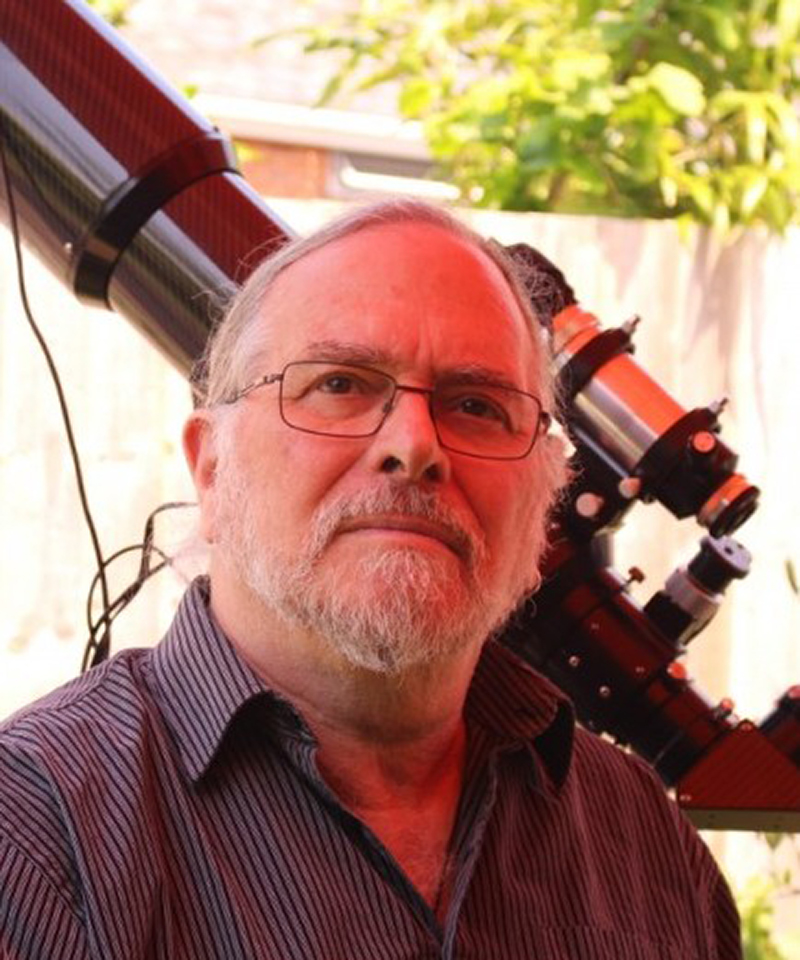Whatever time of year you happen to be reading this, there are bound to be at least a few wonderful targets to see in the night sky tonight with binoculars.
Indeed, there are hundreds of astronomical bodies that a pair of binoculars will bring into view for you.
Not only will binoculars let you see many more objects than you can with the naked eye, but the detail and colour in those objects become a lot richer.
With binoculars, the Coathanger asterism in Vulpecula actually looks like a coathanger and the Orion Nebula becomes a fantastically detailed painting of light.
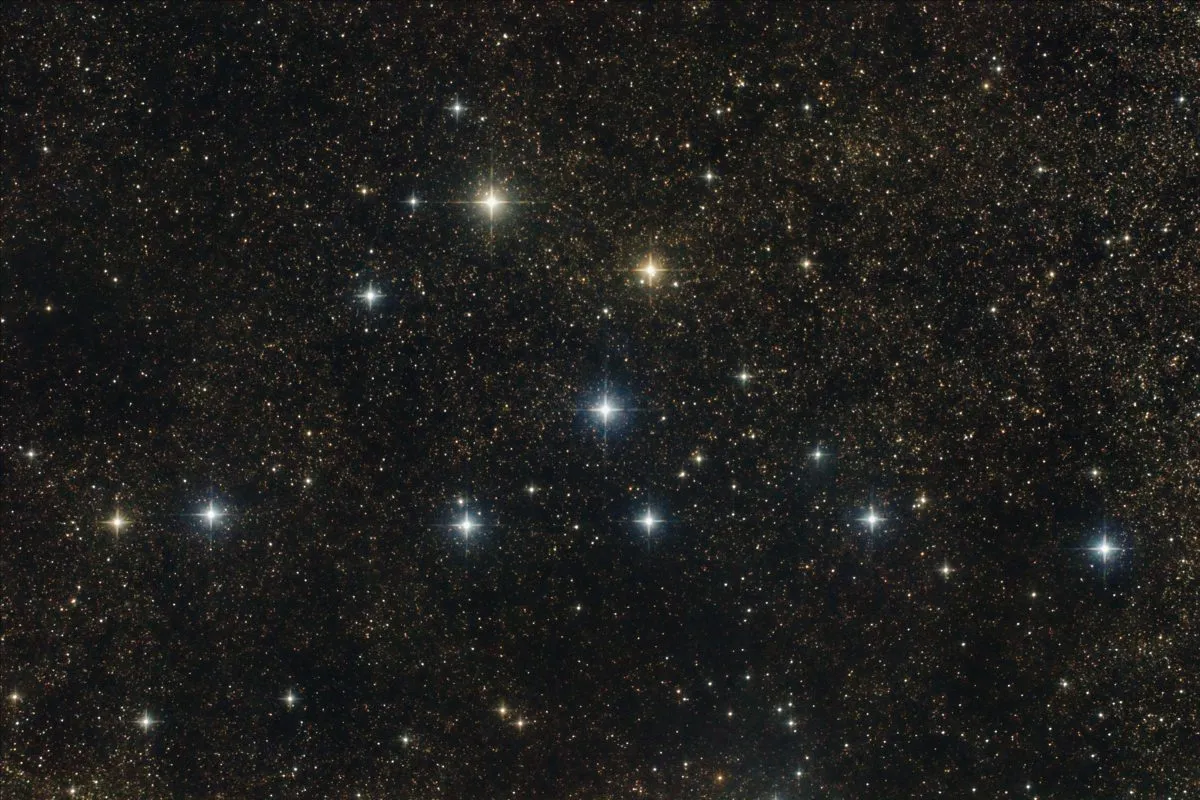
The Milky Way is no longer a tenuous glowing band, but a knotted tangle of stars, interspersed with mysterious dark patches.
Albireo goes from being an ordinary-looking star that marks the head of Cygnus to an exquisite binary juxtaposition of gold and sapphire.
And you can easily see galaxies by the light that left them millions of years ago, when our ancestors were thinking about leaving the trees.
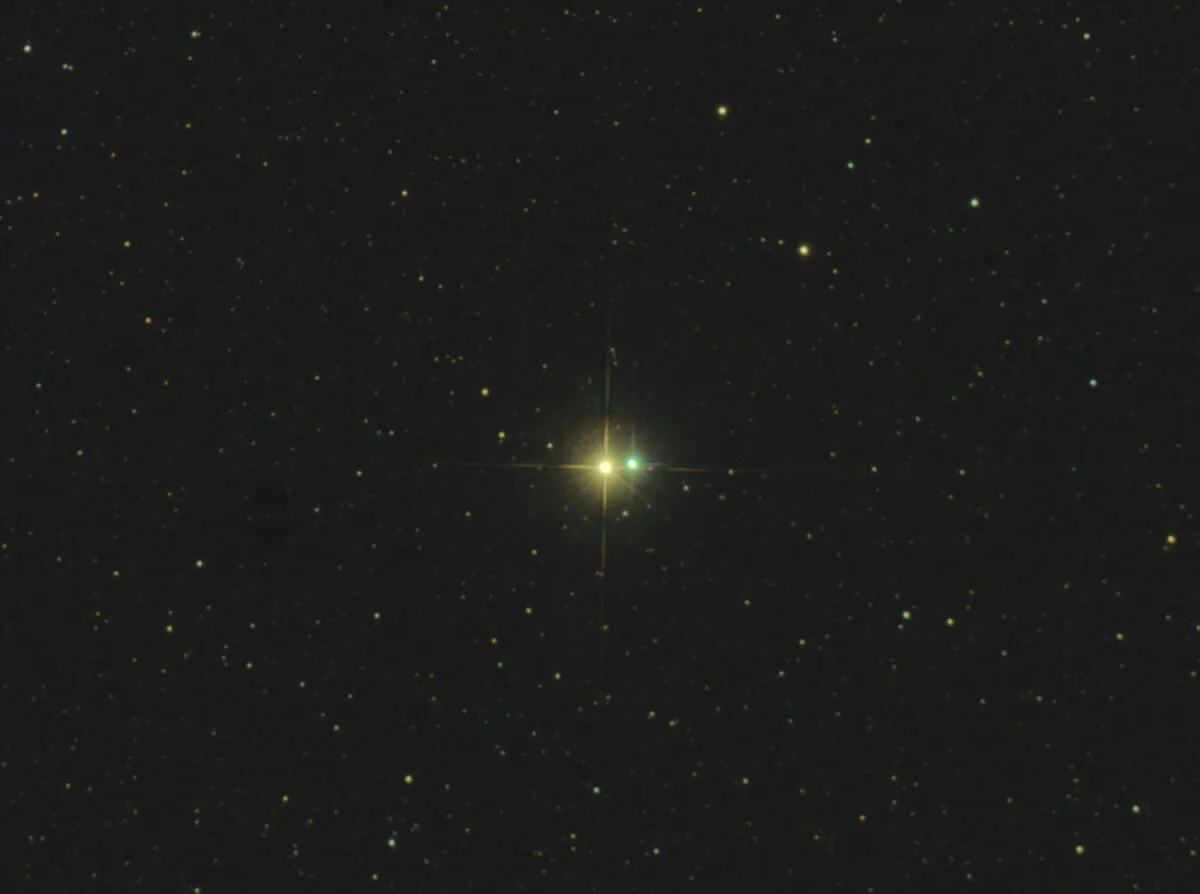
Binoculars are still suitable even if you want to do ‘serious’ astronomy.
There are variable star observing programmes specifically for binoculars, and their portability makes them ideal for taking to the narrow track where a lunar graze or asteroid occultation is visible.
Alternatively, you could wrap up warm, lie back on your garden recliner and just enjoy the objects that the binoculars let you find as you cast your gaze among the stars.
Before you even realise it, you have begun to learn the sky and you’ll soon be able to navigate around it better than the entry-level Go-To telescope you nearly bought instead.
Best of all, you can have this complete observing system for two eyesfor less than the price ofone reasonably good telescope eyepiece.
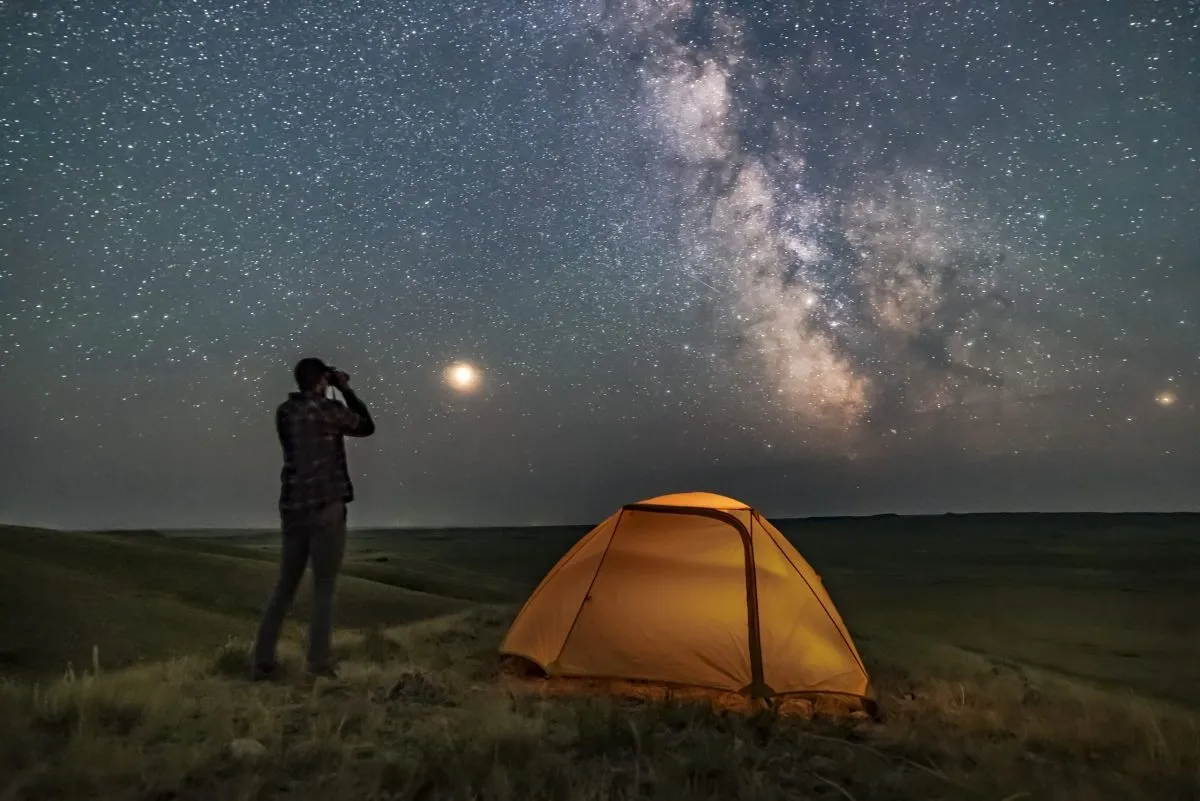
In this guide we'll go through 6 wonderful targets that are visible in the night sky through binoculars.
We'll update the guide every month so you always have something new to observe, and as this archive grows you can scroll back through previous years of the current month and try and find those targets too.
Each binocular tour is made all the easier by downloading our PDF charts, the links for which you can find just at the top of each section below.
The tour charts are black on white, so you can read it under red light and avoid spoiling your night vision.
For more advice, read our guide to stargazing with binoculars, our pick of the best binoculars for astronomy and the best budget binoculars.
6 binocular night-sky targets for April 2024
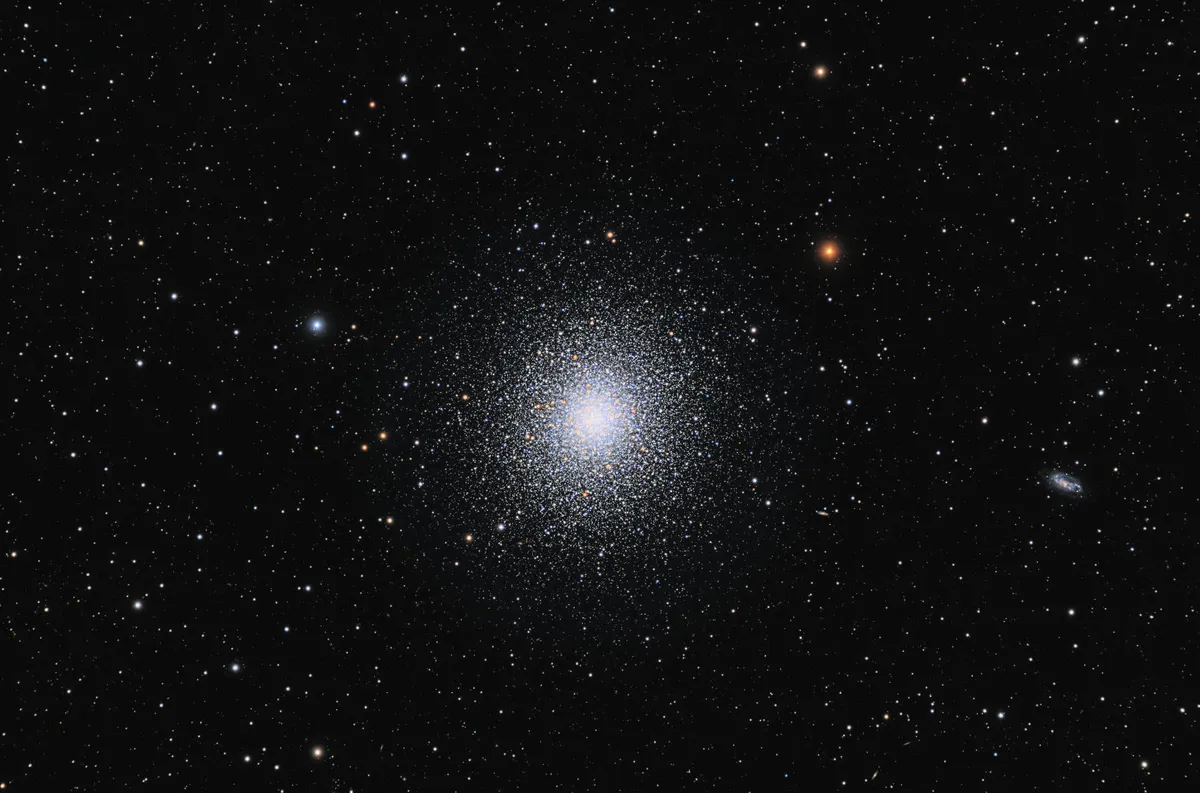
Download our April 2024 binocular tour form (PDF)
1 - M13, the Great Cluster in Hercules
As we approach the season for trying a Messier marathon, M13 reminds us why Charles Messier created his famous catalogue of objects not to be mistaken for comets, known as the Messier Catalogue.
The great Hercules globular cluster lies one-third of the way down the western side of the Keystone asterism. In binoculars, it looks just like a comet, brightening towards the core. You might even be able to see it with your naked eye in very transparent skies.
2 - Nu Coronae Borealis
Nu (ν) Coronae Borealis appears as a double to your naked eye and is therefore easily split in small binoculars. The stars of this optical double (a chance line-of-sight pairing of stars that are not gravitationally bound) are both giants of about 2.5 solar masses.
Although the brighter star, mag. 5.2 Nu1 (ν1), is more distant, it’s at a later stage of evolution and therefore more luminous than mag. 5.4 Nu2 (ν2).
3 - Tau Coronae Borealis group
Navigate 4° northwest from Nu (ν) Coronae Borealis to find mag. 4.7 Tau (τ) Coronae Borealis, the brightest star in a very pretty, straight chain of five stars running east–west for 2.6°.
All but the central star, a mag. 7.4 triple star resolvable in binoculars, shine brighter than magnitude 6, and binoculars reveal their colours. Notice that the mag. 5.6 stars at the ends of the chain are a deeper yellow than the others.
4 - R Coronae Borealis
Lying in the middle of the Northern Crown, R Coronae Borealis usually shines at mag. 5.9, but the brightness of this enigmatic variable star randomly plummets as low as mag. 15, like a reverse nova.
It does this very quickly, so it’s worth observing the star on every clear night. R Coronae Borealis periodically puffs out jets of carbon which, if they are in line of sight with us, obscure this ‘sooty’ carbon star.
5 - Delta Boötis
Mag. 3.5 Delta (δ) Boötis is a very easy double. The primary is a deep-yellow giant nearly 60 times more luminous than the Sun. Its mag. 7.8 companion, 105 arcseconds to the east, is slightly paler.
At 117 lightyears distance from us, that 105 arcseconds translates to an enormous 0.6 lightyears apart. At that separation, the orbital period of this binary system is about 120,000 years.
6 - RV Boötis
The reddish variable (mag. 7.2 to 8.7) star RV Boötis is a little more than 2.5° northeast of mag. 3.6 Rho (ρ) Boötis, in between two mag 6.3 stars, the brightest in the field of view.
RV Boötis is a semi-regular variable with a period of 288 days. The Sun will eventually become like RV Boötis, with an inert core surrounded by helium- and hydrogen-burning shells within a hydrogen envelope.
6 binocular night-sky targets for March 2024
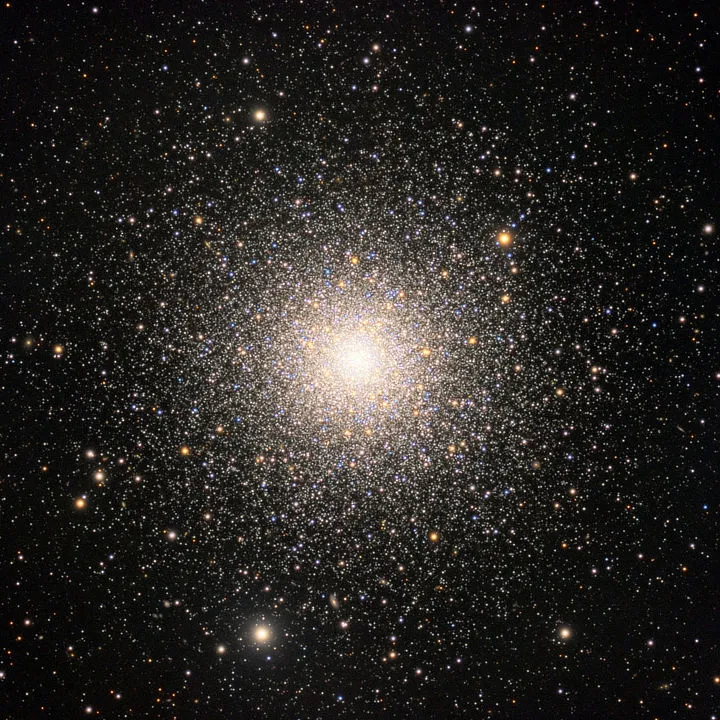
Download our March 2024 binocular tour form (PDF)
1 - Melotte 111
We’ll start with a favourite ‘made for binoculars’ target. Look midway between mag. 2.9 Cor Caroli (Alpha (α) Canum Venaticorum) and mag. 2.1 Denebola (Beta (β) Leonis) and you should see a misty patch about 6° across.
Your 10x50s will resolve it into 30 or more stars, all of which are mag. 10.5 or brighter; any fainter ones have been gravitationally ejected from the cluster by a process called mass segregation.
2 - M53
A degree northeast of mag. 4.9 Diadem (Alpha (α) Comae Berenices), there’s a small misty patch that appears to grow in size and brightness if you centre it in the field of view but look at Diadem.
This is the globular cluster M53, and the trick you used to make it grow is averted vision, which puts the light from the object onto a more sensitive part of your retina. We’ll use it later for galaxy hunting.
3 - M3
Our next target is one of the finest globular clusters in the northern sky, but there are no nearby bright stars to help you find it. However, if you look half-way between mag. –0.1 Arcturus (Alpha (α) Boötis) and Cor Caroli, you should find what looks like an out-of-focus star.
Use averted vision and you will see more of the glow of the nearly half-million stars that comprise M3, discovered by Charles Messier in 1764.
4 - M94
Return to Cor Caroli and imagine a line between it and mag. 4.2 Chara (Beta (β) Canum Venaticorum). From half-way along this line, navigate 1.6° to the northeast. Here, possibly needing averted vision at first, you should find the 13.6-million-year-old glow of light from the spiral galaxy M94.
Like all galaxies, it benefits greatly from dark, transparent skies, but it is usually quite easy to see even in suburban skies.
5 - M49
Locate mag. 4.9 Rho (ρ) Virginis and place it on the northeast of your field of view. On the opposite side you’ll see two sixth-magnitude stars, just over a degree apart and orientated southeast–northwest.
The 37-million-year-old fossil light from M49 is the small, oval patch between them. Using averted vision, see how many more galaxies you can find between M49 and Melotte 111.
6 - 86 Leonis star field
Let’s finish with a colourful star field. Locate the orange-yellow mag 5.6 86 Leonis between Denebola and mag. 2.6 Zosma (Delta (δ) Leonis); compare it to brilliant-white mag. 6.3 90 Leonis, 2° back towards Denebola.
Find the curved string of multicoloured seventh and eighth-magnitude stars that extends 3° eastward from 86 Leo. Scan northeast of here too, if you like colourful stars.
6 binocular night-sky targets for February 2024
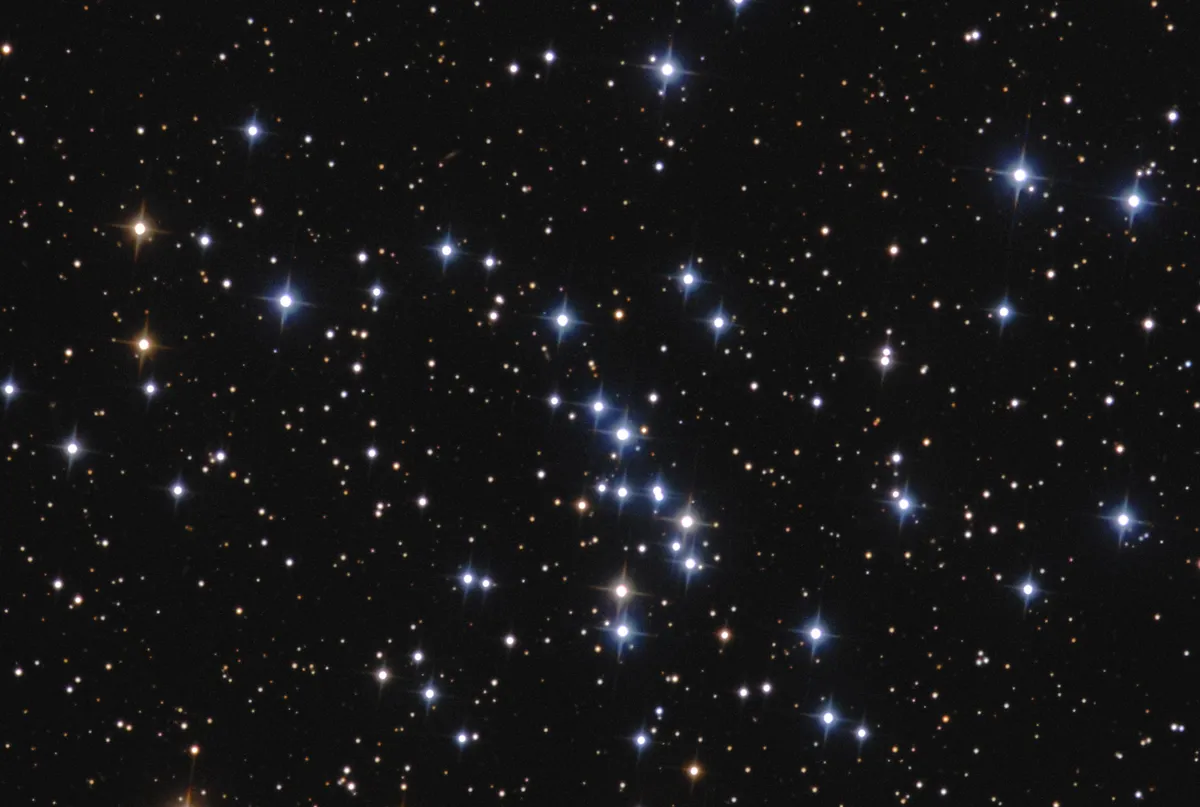
Download our February 2024 binocular tour form (PDF)
1 - The Hydra’s Head
The one immortal head of the Hydra, the longest constellation, is defined by six stars, but only the faintest, mag. 4.4 Sigma (σ) Hydrae, retains a name – Minchir (the nostril) – that relates to Heracles’s nine-headed nemesis.
Binoculars enable you to enjoy the wide variation in colours, from the intense white of mag. 4.3 Eta (η) Hydrae to the yellow-orange of mag. 3.1 Zeta (ζ), the brightest of the six.
2 - The Missing Messier, M48
It was 12 years after Charles Messier incorrectly catalogued the position of M48 that Caroline Herschel rediscovered it, but it took over a century and a half for astronomers to realise she’d found the object that matched Messier’s description.
Find this open cluster 3° southeast of mag. 4.4 Zeta (ζ) Monocerotis, as a condensed patch of stars of which you can resolve a few brighter members against a rich background glow.
3 - M50
Use the chart at the link above to locate M50, an obvious circular glow about half the apparent diameter of the Moon. This 78-million-year-old cluster lies 3,200 lightyears away and measures about 20 lightyears across.
The glow comes from a little more than 100 stars, but don’t expect to resolve more than four or five of them in 10x50 binoculars, the number depending on the darkness and transparency of your sky.
4 - 14 CMi
Mag. 5.3 14 Canis Minoris is the middle star in a slightly curved line of three in the southeast of Canis Minor. This deserves a closer look, ideally using larger binoculars, which will show you that it’s actually a triple star, with two very much fainter companions.
The brighter one (mag. 9.4) lies 102 arcseconds to the east, and the other (mag. 9.8) is 137 arcseconds to the southeast of 14 CMi.
5 - The Beehive Cluster (M44) and the Manger
Named by the ancient Greeks as Nephelion, the Little Cloud, M44 is an ideal object for binoculars. It is framed by an asterism of four bright stars known as Praesepe (the Manger), and is visible to the naked eye as a misty patch just north-northeast of mag. 3.9 Asellus Australis (Delta (δ) Cancri).
It is one of the nearest open clusters and contains over 1,000 stars.
6 - Iota Cancri
You should be able to identify this month’s tricky target, mag. 4.0 double star Iota (ι) Cancri, with your naked eye. Its primary member is a yellow giant and its secondary is a mag. 6.0 white dwarf, 30 arcseconds to the northwest.
The magnification of 15x70s will help you split this true binary star, which has an orbital period of 65,000 years.
6 binocular night-sky targets for January 2024
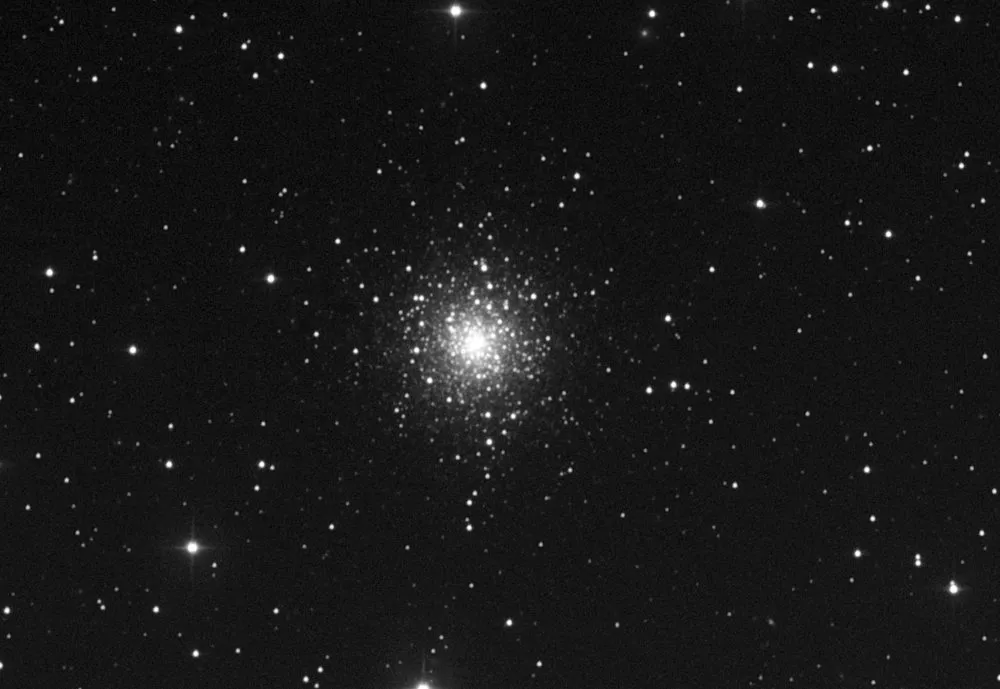
Download our January 2024 binocular tour form (PDF)
1 - The Stream
Let’s start the tour 6° to the west of mag. 3.3Mu (µ) Leporis, where you’ll find the orange mag. 5.0 60 Eridani at the north of a 4.5° chain of stars.
Follow the chain through yellow 59 and 58 Eridani, via a white star, to the reddish mag. 4.3 54 Eridani, the brightest star in the group. On a transparent night, see how many fainter stars you can see, especially near the top of the chain.
2 - Iota and RX Leporis
Nearly 4° south of mag. 0.3 Rigel (Beta (β) Orionis) lies mag. 4.5 Iota (ι) Leporis, a brilliant-white star that contrasts beautifully with the fainter reddish star RX Leporis that lies 0.25° to the west of it.
RX Leporis is slightly variable, oscillating between magnitudes 5.1 and 6.7 over a period of 79.5 days, but this main period is overlaid by longer periods and it is classified as an ‘unsolved’ semi-regular variable.
3 - Zibal
The pure-white mag. 4.8 Zibal (Zeta (ζ) Eridani) should be just visible to your naked eye if your southern aspect is good. It’s part of a wide pair, the other member being mag. 6.1 14 Eridani (mag. 6.1), 0.5° to the south-east.
Close examination will reveal another companion northwest of Zibal, a mere 5 arcminutes away, shining at mag. 6.6. Both of these companions are line-of-sight associations.
4 - 62 Eridani
Use the chart to identify mag. 2.7 Cursa (Beta (β) Eridani). Linger for a while, taking time to appreciate its rich and colourful stellar environment, before heading 3° due west to the brilliant blue-white magnitude 5.5 62 Eridani.
This can be a tricky double star, not because of the separation, which is a substantial 66 arcseconds, but because the line of sight companion is so much fainter (mag. 8.9) than 62 Eridani.
5 - CV Eridani
In the northwest corner of Eridanus lies a little triangle of stars that covers about the same amount of sky as the Moon. The most easterly of these is mag. 6.1 7 Eridani, also designated CV Eridani.
‘CV’ indicates that it’s a variable star, but the reason for its inclusion here is the beautiful contrast of its redness against the whiteness of the other two stars in the triangle.
6 - M79
Identify mag. 2.6 Arneb (Alpha (α) Leporis) and mag. 2.8 Nihal (Beta (β) Leporis) and mag. 3.6 Gamma (γ) Leporis. Extend a line from Arneb to Nihal southwards for just over 4°, where you will find a mag. 5.4 star.
Without looking away from this star, turn your attention to a spot about 0.5° away in the direction of Gamma. What looks like a faint fuzzy star is the globular cluster M79.
6 binocular night-sky targets for December 2023
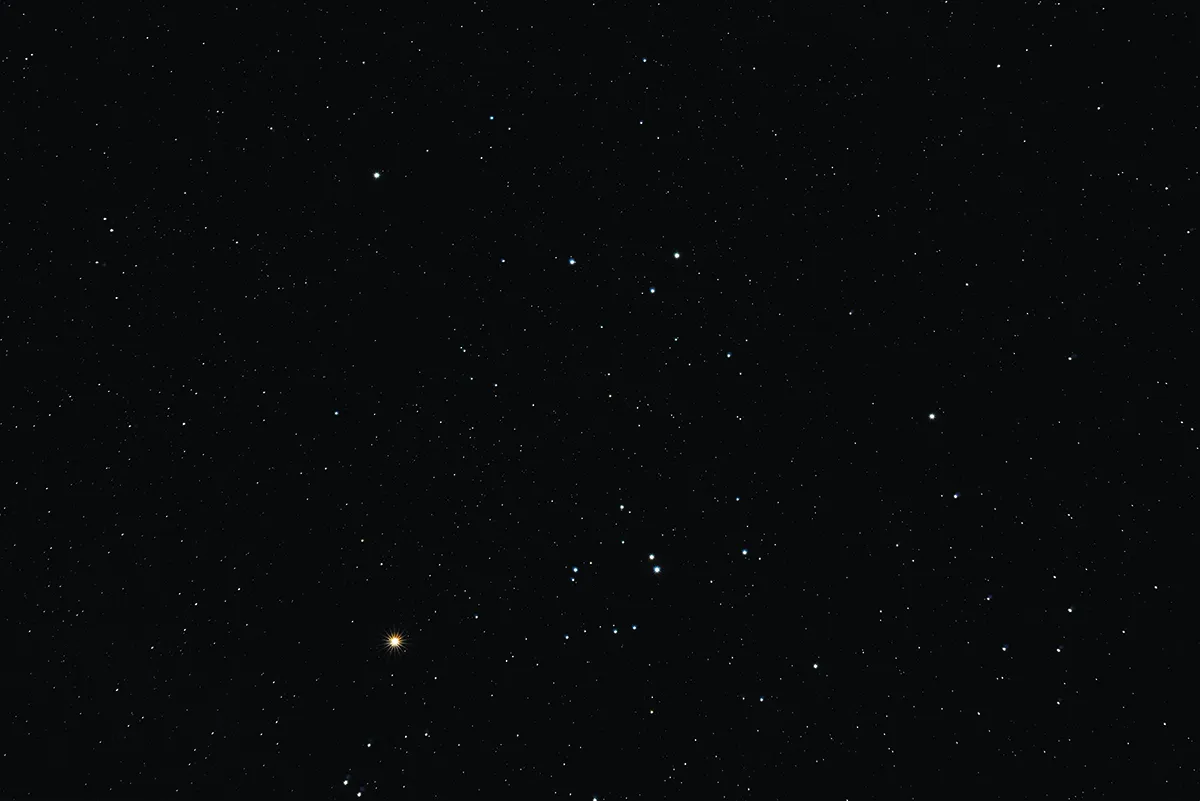
Download our December 2023 binocular tour form (PDF)
1 - The Hyades
The Hyades cluster is next to mag. 1.0 Aldebaran (Alpha (α) Tauri), the reddish eye of the Bull, which is not part of the cluster but a foreground star. The cluster is only 153 lightyears away, making it the nearest open cluster to us.
In mythology, the Hyades were the daughters of Atlas, and their weeping for their brother Hyas, who was slain by a lion, is the rain that is associated with their heliacal setting in spring.
2 - NGC 1647
About 3° northeast of Aldebaran is a lovely little cluster, NGC 1647, often ignored because of the presence of its more prominent neighbour.
With 10x50s you should be able to see eight or nine stars against a background glow about one and a half times the apparent size of the Moon. It’s actually twice the size of the Hyades, but nearly 12 times the distance, which is why it seems so small
in comparison.
3 - NGC 1662
Switch to larger binoculars for our next target, 6.25° from Aldebaran in the direction of mag. 0.3 Rigel (Beta (β) Orionis). In 15x70 binoculars, NGC 1662 appears as a complex winding string of stars against an elliptical background glow.
With a core of about 10 lightyears diameter, it’s approximately the same size as the Hyades, but is nearly 10 times as far away.
4 - Collinder 70
Most amateur astronomers have seen Collinder 70 without realising it: it’s the oval-shaped group of very young bluish-white stars that surrounds the Belt stars of Orion.
On a clear night, you should be able to see at least 70 stars in this magnificent cluster. They form some beautiful curved chains, in particular the S-shaped chain that weaves its way between mag. 1.8 Alnilam (Epsilon (ε) Orionis) and mag. 2.4 Mintaka (Delta (δ) Orionis).
5 - The Great Nebula in Orion
The Orion Nebula, M42, is a highlight of the winter skies and a superb object in binoculars of any size. It’s the nearest stellar nursery to Earth and is visible to the naked eye as the fuzzy central ‘star’ of Orion’s Sword.
It is extremely sensitive to sky transparency and is best observed soon after rain has cleaned the sky of dust, revealing its exquisite, intricate detail.
6 - M78
This demands mounted binoculars, a very transparent sky and averted vision. Put mag. 1.9 Alnitak (Zeta (ζ) Orionis) just outside the south-southwest of the field of view and a small misty glow should appear near the centre.
Brighter at the top than at the bottom, it looks like a comet, showing why Charles Messier put it in his catalogue of objects for comet-hunters to ignore, known as the Messier Catalogue.
6 binocular night-sky targets for November 2023
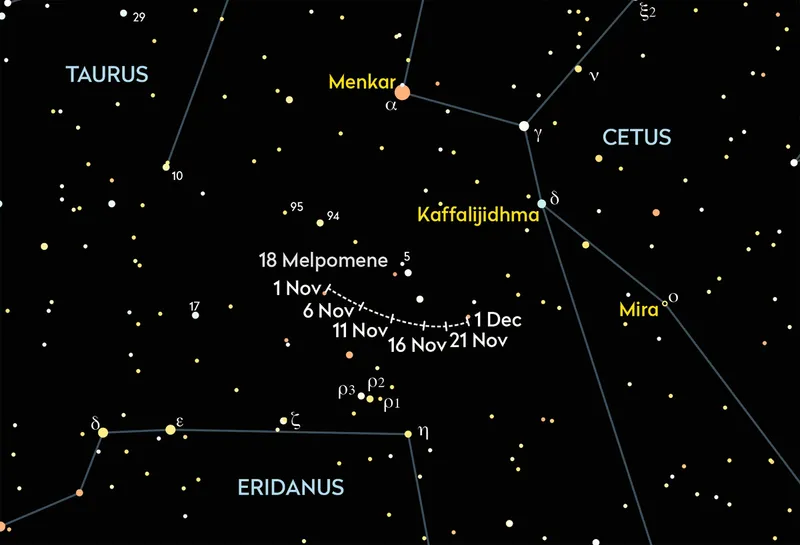
Download our November 2023 binocular tour form (PDF)
The Cosmic Question Mark
Use the chart at the link above to identify mag. 4.9 Nu (ν) Ceti and hold it at the bottom half of the field of view. You’ll see that it is the dot at the bottom of the 2.25°-long question mark asterism (an informal group of stars).
This is a good star-party object, both because of its shape and the colours of the fainter stars that make up the rest of the asterism.
The Pisces Parallelogram
If you follow a line up from mag. 2.0 Deneb Kaitos (Beta (β) Ceti; also known as Diphda) through mag. 3.5 Iota (ι) Ceti, you will find four stars of fifth magnitude (or so) that form a 3° x 1° parallelogram.
The northeast corner is blue-white 29 Psc, and diagonally opposite is orange 30 Psc; the other two corners of the parallelogram appear yellowish. See how the parallelogram appears empty: it contains only one star brighter than eighth magnitude.
T Ceti
Return to Deneb Kaitos and find the mag. 4.4 star 7 Ceti, 7° to the west. From there, go 2° to the southeast to T Ceti, the most westerly star in an equilateral triangle of sixth(ish)-magnitude stars, with a side of 1.5°.
T Ceti is a semi-regular variable star (mag. 5.0 to 6.9) with a period of 159.3 days. If you observe it every couple of weeks you should be able to notice this variation.
37 Ceti
The double star 37 Ceti lies nearly 2.5° west of mag. 3.6 Theta (θ) Ceti. Its components are 49 arcseconds apart, which theoretically should be an easy split, even with lower magnifications.
But the magnitude of the companion is only 7.9, which is 13 times less bright and can make splitting it a bit of a challenge. This is an optical double (a chance line-of-sight pairing), not a true binary star.
The Silver Coin Galaxy and NGC 288
With a good clear southern horizon, find the right-angled triangle of fifth-magnitude stars 5° south of Deneb Kaitos. Look below it for a rhombus of fainter stars. You’ll see the Silver Coin Galaxy (NGC 253) as an elongated glow about 1° beneath the rhombus.
Next look slightly less than 2° in the direction of Alpha (α) Sculptoris, where you should see the faint glow of the globular cluster NGC 288.
Melpomene
Asteroid 18 Melpomene has a very elliptical orbit with a period of 3.48 years, so approximately every seven years, when it’s near its perihelion, it appears brighter than usual.
It’s at peak brightness (mag. 8.2) at the beginning of November. To identify it, observe its environs over several nights to determine which ‘star’ moves relative to the others.
6 binocular night-sky targets for October 2023
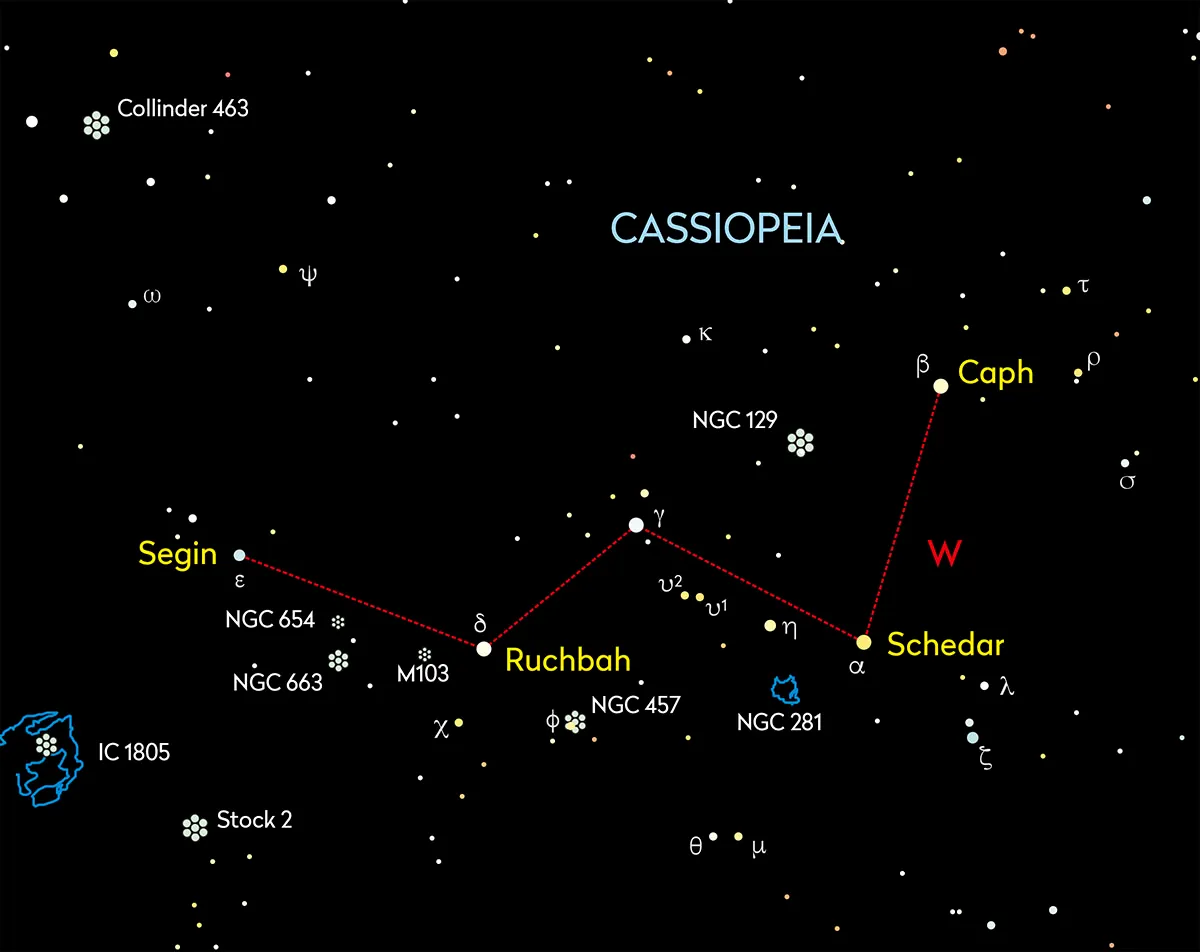
Download our October 2023 binocular tour form (PDF)
This month's targets are all located in and around the constellation Cassiopeia.
Kurhah star field
The very white mag. 4.4 Kurhah (Xi (ξ) Cephei) is the most northerly and brightest star of a lovely group that stretches southward for about 3°. There are some very red stars like mag. 5.2 18 Cephei and, at the other extreme, hot blue mag. 5.1 19 Cephei.
Give yourself time to appreciate the sheer variety of what’s on show and look around for the other, fainter groups of colourful stars that lurk nearby.
U Cephei
Eclipsing variable star U Cephei lies midway between two white mag. 5.6 stars, 7.5° from mag. 2.0 Polaris (Alpha (α) Ursae Minoris), the North Star, in the direction of mag. 2.1 Gamma (γ) Cassiopeiae.
Its magnitude range is 6.8 to 9.2, a nine-fold variation in brightness over a period of 2.5 days which, coupled with it being circumpolar from the UK, makes it a suitable subject for newcomers to variable star observing.
35 Cassiopeiae
If you imagine that Segin (Epsilon (ε) Cassiopeiae) and Ruchbah (Delta (δ) Cassiopeiae) and Gamma (γ) Cassiopeiae are the apexes of a rhombus, you’ll see a triangle of stars near the fourth apex.
The one nearest to Segin is mag. 6.3 35 Cassiopeiae, a very white star, but can you detect any colour in its mag. 8.4 companion 1 arcminute to the north? This is a line-of-sight pairing, not a true binary star.
Cassiopeia triple cluster (NGC 654, 659, 663)
Look 1° to the east of the middle of an imaginary line joining Segin and Ruchbah and you’ll easily find the largest and richest of these clusters, NGC 663. Slightly less than 1° to the north-northwest is the brighter but smaller NGC 654.
The poorest of the trio is NGC 659, a tiny ghostly glow which may need averted vision, just on the NGC 663 side of mag. 5.8 44 Cassiopeiae.
The Owl Cluster, NGC 457
Start at Ruchbah and navigate 2° southwest to mag. 5.0 (Phi (φ) Cassiopeiae) and its mag. 7.0 companion 2 arcminutes further on. These are the owl’s eyes.
The Owl Cluster's body and wings are ninth and 10th-magnitude stars that span an area about 0.25° in the direction of Gamma Cassiopeiae. The brighter eye is not actually part of NGC 457; it lies half-way between us and the 8,000-lightyear-distant cluster.
The Muscleman Cluster
Identify the Perseus Double Cluster (NGC 884 and NGC 869) and from the part nearest to Cassiopeia follow a 2° chain of eighth-magnitude stars north to Stock 2, the Muscleman Cluster.
This gets its name from the brighter stars having the form of a stick-man in muscle-flexing body-builder pose, ripping this star-chain away from the Double Cluster.
6 binocular night-sky targets for September 2023
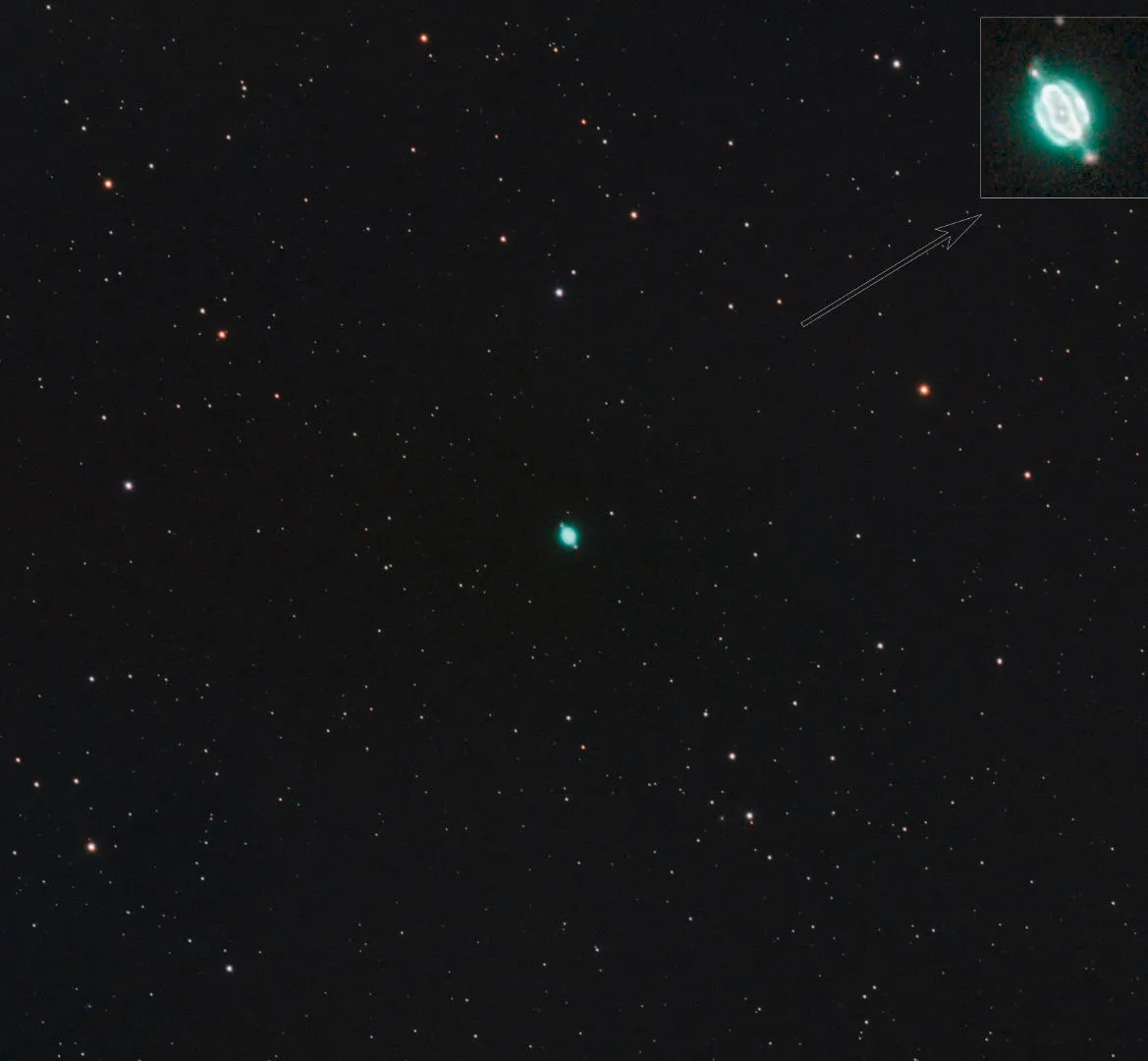
Download our September 2023 binocular tour form (PDF)
M2
Charles Messier described the globular cluster M2 as “a nebula without stars”. You’ll find it due north of Sadalsuud (Beta (β) Aquarii) and due west of Sadalmelik (Alpha (α) Aquarii).
It’s obvious in a star-sparse region of sky; even in small binoculars you should be able to see this 38,000-lightyear-distant glow. If you use averted vision, it will appear to grow slightly and may appear very slightly oval in shape.
Σ2809
From M2, head slightly more than a degree east-northeast to a mag. 6.2 star. This is the brighter component of a double-star system, Struve 2809.
Seeing the fainter companion is a good test of both 10x50 binoculars and your observing technique, because it’s a mere 31 arcseconds to the south-southeast and shines at only mag. 9.3. Don’t expect to see it consistently; it may ‘fade’ in and out of visibility.
Saturn and Titan
Saturn is the brightest object in the area covered by the chart, so is easy to locate. You won’t see the rings in 10x50 binoculars, but you can see the brightest moon, Titan, which shines at mag. 8.4.
Its period of orbit around Saturn is nearly 16 days and its angular distance from the planet ranges between 0.5 and 3 arcminutes, so the second-largest moon in the Solar System is quite easy to spot. ο
The Saturn Nebula, NGC 7009
If you want a good binocular observing challenge in British skies, this is a top candidate. Fortunately,
it’s very easy to locate, 1.3° due west of mag. 4.5 Nu (ν) Aquarii.
It appears as a slightly defocused star but, because it’s only about 0.4 arcminutes across, at this magnification you’ll not be able to see the elongation that Lord Rosse detected when he gave it its common name.
8 Flora
Here’s a rare opportunity to spot asteroid 8 Flora in binoculars. It starts the month at mag. 8.5, 6.7° south of Saturn and fades by a bit more than half a magnitude as it tracks 5° west-southwest during the month. It will be hard to identify against the background stars, so you’ll need to observe on several occasions to detect which of these ‘stars’ moves in relation to the others.
6. M30
If you plan to do a Messier Marathon (observing all 110 Messier objects between dusk and dawn) next spring, M30 is one you need to be confident of finding, being the difficult last object in a lightening dawn twilight sky. Autumn evenings are a very good time to start this practice. You’ll find it half a degree from mag. 5.2 41 Capricorni in the direction of mag. 3.7 Zeta (ζ) Capricorni.
6 binocular night-sky targets for August 2023
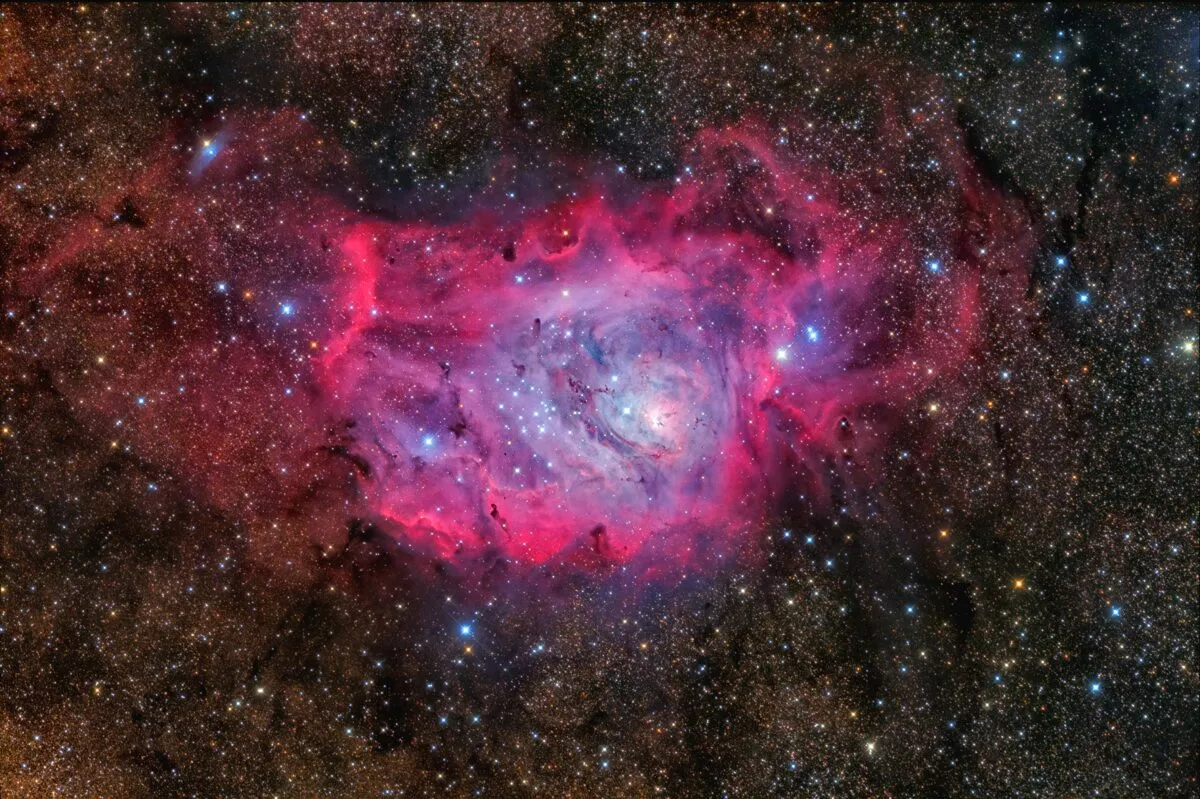
- Download our August 2023 binocular tour form (PDF)
M11, the Wild Duck Cluster
Our tour of the southern portion of the Milky Way begins with one of the densest open clusters, M11, the Wild Duck Cluster. You’ll find it 2° southeast of mag. 4.2 Beta (β) Scuti, spanning about 0.25° of sky.
In 10x50 binoculars, the cluster appears as a bright, slightly wedge-shaped glow. Were it not so rich, you may have had trouble identifying it against the Scutum Star Cloud, the densest part of the Milky Way.
M26
If you put mag. 3.8 Alpha (α) Scuti at the northwest of your field of view, open cluster M26, also known as NGC 6694, will be southeast of centre. Although it is only mag. 8.0, M26 is easy to find.
Look for a glowing kite shape which has the unusual feature of being less bright in the middle, due to some intervening interstellar dust, so what you see is an open cluster with a tiny dark nebula in the middle.
M24, the Sagittarius Star Cloud
M24 lies slightly more than half-way from mag. 4.7 Gamma (γ) Scuti to mag. 3.8 Polis (Mu (µ) Sagittarii). It is a bright patch of light that is easily visible to the naked eye and which has even been mistaken for a cloud just above the horizon.
It is a remarkably good object in 10x50 binoculars, in which nearly 1,000 stars are resolved in a single field of view!
M25 and U Sagittarii
If you navigate 4.5° south from Gamma Scuti, you should easily find the bright (mag. 4.6) open cluster M25, showing distinctly against the background Milky Way, with eight or so stars resolved against a grainy background.
It’s easier to distinguish the cluster from the background Milky Way in small binoculars than in large ones. The brightest star in the cluster is the Cepheid variable, U Sagittarii (which varies from mag. 7.2 to 6.5).
M23
M23 is just over half-way from mag. 3.5 Xi (ξ) Serpentis to Polis, but may be difficult to distinguish from the rich background of the Milky Way.
This bright, oval (15x27 arcminutes) open cluster is lovely in 70mm binoculars, which reveal about a dozen stars in the shape of a lower-case letter alpha (α) against the background glow of another 140 fainter stars.
M8, the Lagoon Nebula
Look for M8, the Lagoon Nebula, 6° west-northwest of mag. 3.0 Kaus Borealis (Lambda (λ) Sagittarii). It is visible to the naked eye if it’s high in a reasonably dark and transparent sky.
With 10x50s you’ll resolve more than half a dozen stars and reveal some of the surrounding nebulosity (NGC 6523) they illuminate, as well as the denser cluster of stars to the east of the main nebulosity.
6 binocular night-sky targets for July 2023
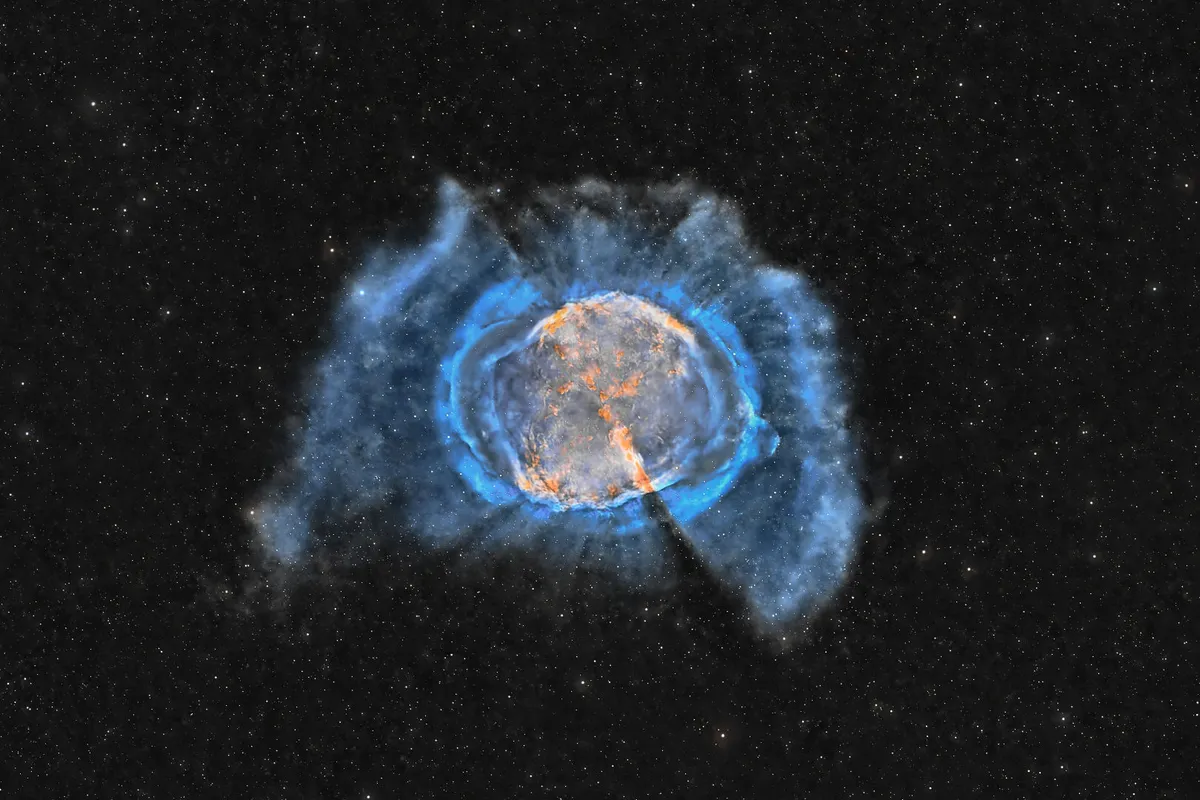
- Download our July 2023 binocular tour form (PDF)
1 - Sadr, the Heart of Cygnus
The mag. 2.2 star Sadr (Gamma (γ) Cygni) is sometimes called ‘the heart of Cygnus’, but it is really only part of the story. If you look carefully, you’ll notice that Sadr is merely the point of inflexion in a cardioid-shaped asterism of 11 mostly 6th-magnitude stars.
It has a diameter of a little less than 2° and offers a wide variety of colours, from deep orange through yellow and white, to an intense blue-white.
2 - NGC 6940
The open star cluster NGC 6940 deserves to be far better known. Use the chart to identify mag. 4.0 41 Cygni and mag. 4.9 30 Vulpeculae and you’ll find NGC 6940 between them, appearing like an oval patch of light that extends to the same apparent diameter as the Moon.
As you study the 2,700-year-old glow, you should be able to resolve eight or so stars of this very pretty cluster, depending on your sky conditions.
3 - The Dumbbell Nebula, M27
Our next stop is the easiest planetary nebula for binoculars, visible even in moderately light-polluted skies. If you place Gamma (γ) Sagittae at the south of a 5° field of view, the mag. 7.4 Dumbbell Nebula will be just north of centre, looking like a tiny luminous cloud.
Initially it will appear rectangular, but with patience you should make out the narrowing in the middle that gives it its common name.
4 - Barnard’s E Nebula
In a dark, transparent sky, this pair of dark nebulae, B142 and B143, which you will find 1° west of mag. 2.7 Tarazed (Gamma (γ) Aquilae) is easy to identify because of the rich Milky Way starfield against which it lies.
These agglomerations of obscuring gas and dust will appear to you as an uppercase ‘E’ or an underlined ‘C’, depending on sky clarity. The easiest bit to see is the middle bar of the E.
5 - Eta Aquilae
What was the first Cepheid variable star to be discovered? Answer: Eta (η) Aquilae (mag. 3.5 to 4.4) – not Delta (δ) Cephei, the star that gave its name to this class of variables.
Edward Piggott found variability in the former a month before John Goodricke found it in the latter. In 1912, Henrietta Leavitt discovered their period-luminosity relationship – the ‘standard candles’ Edwin Hubble then used to measure galactic distances.
6 - M15
Easy globular cluster M15 is one 15x70 field of view northeast of Delta (δ) Equulei. Don’t expect it to look even half as wide (18 arcminutes) as the published data suggests.
Most of its stars are in a core so dense that even the Hubble Space Telescope can’t resolve it, and only the central 7 arcminutes is visible in 70mm binoculars. ο SEEN IT
6 binocular night-sky targets for June 2023
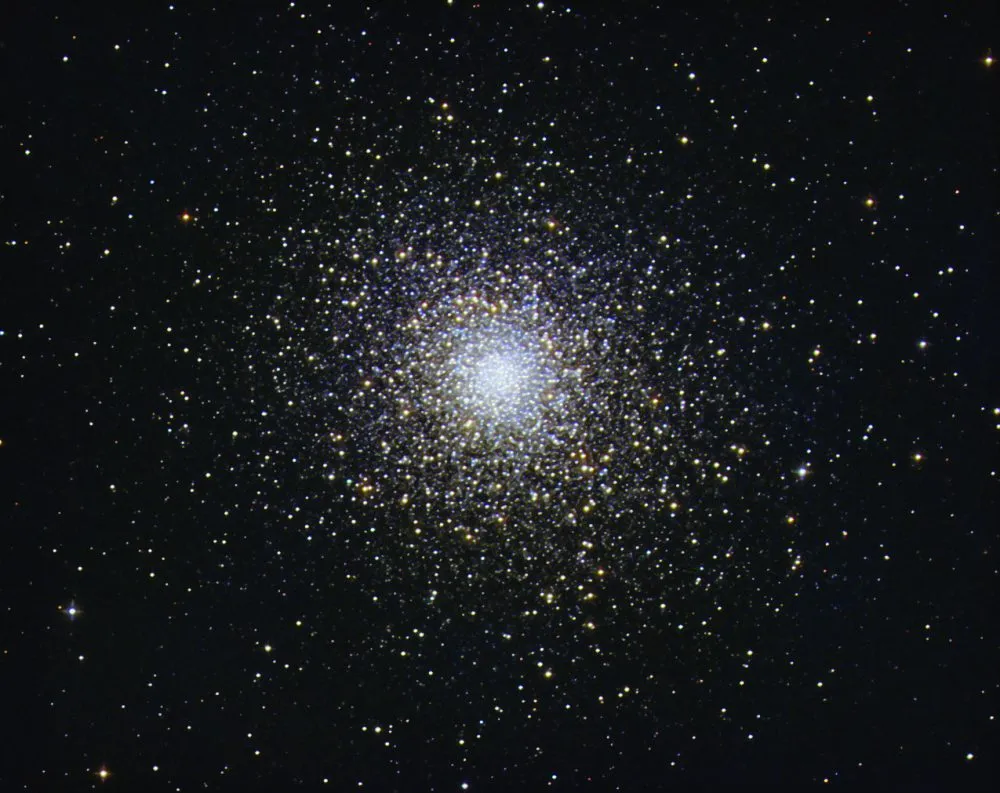
- Download our June 2023 binocular tour form (PDF)
1 - M5
Let’s start with a fine globular cluster, M5, immediately north-northeast of mag. 5.0 5 Serpentis. It contains mostly Population II stars, which are among the oldest stars that we can see.
They are thought to be more than 12 billion years old, which suggests that they formed very soon after our Galaxy did. In 10x50 binoculars, you should notice that M5 brightens towards the centre, exactly like a comet does.
2 - Zubenelgenubi
In antiquity, the stars of Libra, the only non-living zodiac constellation, represented the claws of Scorpius, and the common name of mag. 2.7 Alpha (α) Librae, Zubenelgenubi, means ‘southern claw’ (the northern claw is mag. 2.6 Zubenelschamali (Beta (β) Librae).
Zubenelgenubi is a nice easy binocular double star. Binoculars easily reveal the mag. 5.2 companion 3.5 arcminutes away.
3 - Delta Librae
You’ll find the variable (mag. 5.8 to mag. 4.4) Delta (δ) Librae 8° north of Zubenelgenubi. It’s an eclipsing binary star (a pair of stars orbiting their common centre of mass) in which the drop in brightness, which lasts for about six hours, occurs as the dimmer star occults the brighter one.
The orbital period is 2.3 days, so even during short summer nights you’ll have several opportunities to notice the magnitude change.
4 - Xi1/Xi2 and 17/18 Librae
Midway between Delta Librae and Zubenelgenubi lie two optical double stars (not gravitationally bound binaries). Mag. 5.8 Xi1 (ξ1) and mag. 5.4 Xi2 (ξ2) Librae are separated by 0.75°.
Half a degree northeast of Xi2 is the other pair, mag. 6.6 17 Librae and mag. 5.8 18 Librae, which are nearly 10 arcminutes apart. There is about 50 lightyears between 17 and 18, and more than four times that between Xi1 and Xi2.
5 - M4
M4 is nearly 1.5° west of bright orange mag. 1.0 Antares (Alpha (α) Scorpii). It is only 7,000 lightyears away, making it appear rather loose, and is one of the few globular clusters in which you may be able to discern some structure with 15x70 binoculars.
M4 lies on the edge of the Milky Way, within a beautifully rich, colourful star-field that is more pleasing in binoculars than in a scope.
6 - Rho Ophiuchi
If you navigate 3° north from M4, you’ll find mag. 5.0 Rho (ρ) Ophiuchi. It is the bright component of a triple star, whose seventh-magnitude companions are 2.5 arcminutes to the north and west, respectively.
If you have an exceptional southern horizon sky and fancy a challenge, see if averted vision enables you to detect a slight brightening surrounding the star.
6 binocular night-sky targets for May 2023
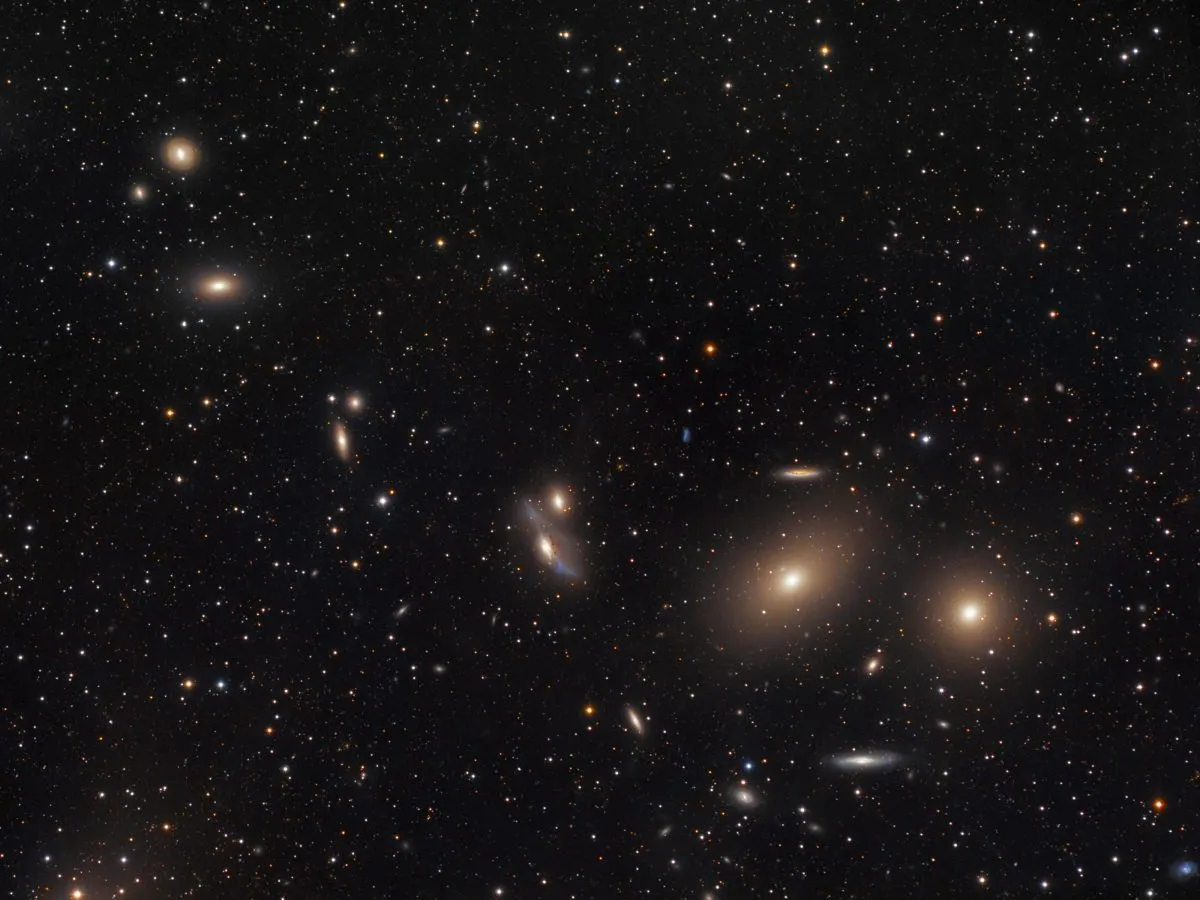
- Download our May 2023 binocular tour form (PDF)
1 - M53
A degree northeast of mag. 4.3 Diadem (Alpha (α) Comae Berenices), you’ll find a small misty patch which appears to grow in size and brightness if you centre it in the field of view then avert your gaze back to Diadem.
The apparent changes, which are typical of globular clusters, demonstrate the difference between direct and averted vision. Practice this technique; you’ll need it later when we seek out the galaxies in Markarian’s Chain
2 - FS Comae
Navigate to a point half-way between Diadem and mag. 4.2 Beta (β) Comae Berenices, then another degree to the west to an orange star, FS Comae, shining somewhere around mag. 6.
The magnitude of this semi-regular variable star varies between mag. 6.1 and 5.3, with a period of 55–58 days. Analysis of the star’s spectrum reveals variations in radial velocity of the star’s surface, which indicates that its variability is due to pulsations in size.
3 - 28 &29 Comae
Head 5° northwest of mag. 2.8 Vindemiatrix (Epsilon (ε) Virginis) to a pair of white stars separated by half a degree and orientated roughly north–south. The southerly one is mag. 6.4 28 Comae, brightest of a little parallelogram of stars.
Mag. 5.7 29 Comae is the brightest of a triple star group. The brighter (mag. 8.6) companion is 5 arcminutes back towards 28 Comae, and the fainter (mag. 9.9) one is an arcminute closer.
4 - Ceres
Ceres was discovered by Guiseppe Piazzi on the first day of the 19th century and is the only dwarf planet visible in standard binoculars.
It fades from mag. 7.8 to mag. 8.4 during the month, but should be easiest to detect around mid-month when the Moon is out of the way and it is 2.2° east of mag. 2.1 Denebola (Beta (β) Leonis).
5 - M49
Locate mag. 4.9 Rho (ρ) Virginis and place it on the northeast of your field of view. On the opposite side you should find a pair of sixth-magnitude stars, a little more than a degree apart and orientated southeast–northwest.
M49 is the small, slightly oval patch of light between these two. Use averted vision to see how many more galaxies you can detect in this region of sky.
6 - Markarian’s Chain
TTheis chain of galaxies known as Markarian's Chain, which you may already have detected north of M49, lies almost exactly half way between Vindemiatrix and Denebola.
Starting with M84 and M86, you should be able to identify at least the seven brightest galaxies in the chain.
6 binocular night-sky targets for April 2023
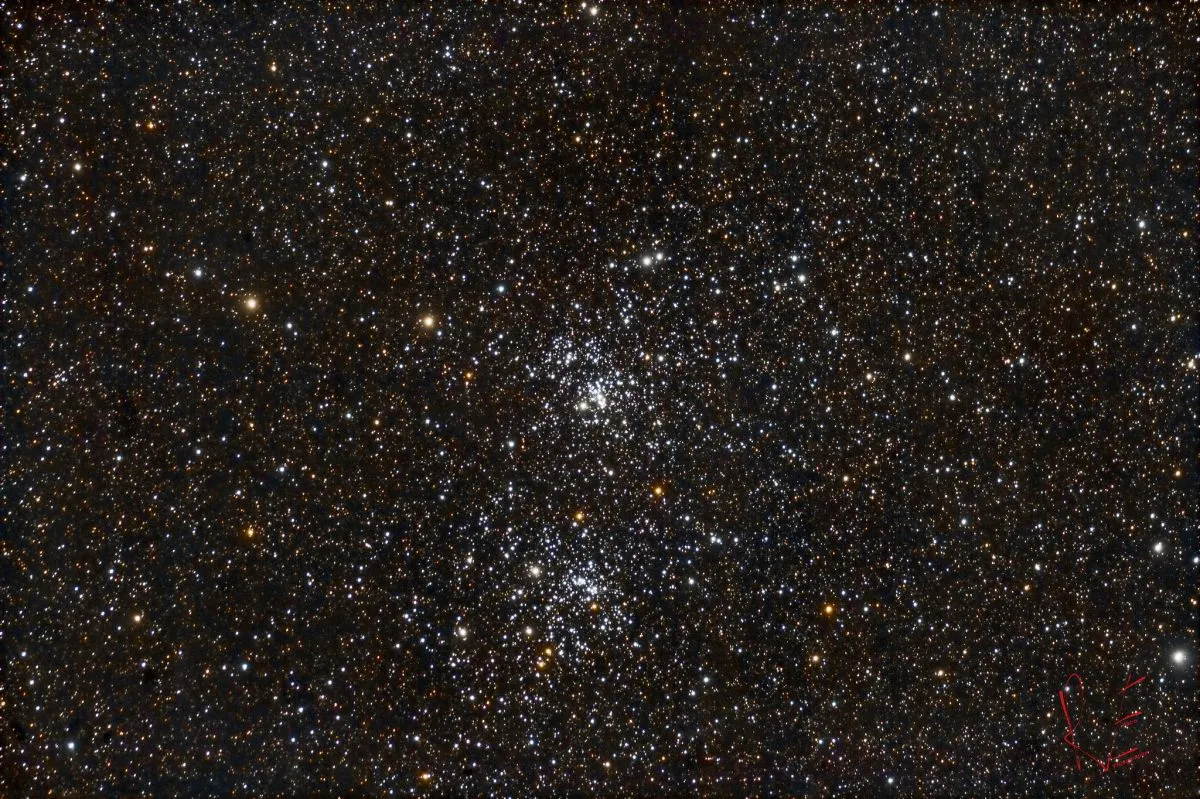
- Download our April 2023 binocular tour form (PDF)
1 - The Double Cluster
Half way between mag. 2.6 Ruchbah (Delta (δ) Cassiopeiae) and mag. +2.9 Gamma (γ) Cassiopeiae you will find a close pair of open clusters. These are known as the Double Cluster.
In a rural sky, you can see them with your naked eye as a distinctly elongated smudge of light, but binoculars will reveal two little concentrations of stars. Those stars are intrinsically extremely bright: if the Sun was there, it would be too faint for you to see it in binoculars!
2 - Melotte 15
If you imagine that mag. +3.3 Segin (Epsilon (ε) Cassiopeiae) and mag. +4.6 Iota (ι) Cassiopeiae are two corners of an equilateral triangle, Melotte 15 is the third corner.
In 10x50 binoculars, you’ll see a large (20-arcminute) glow with a handful of brighter stars forming a V shape. If you have a UHC filter to hold over an eyepiece, you might see the nebulosity (IC1805, the Heart Nebula) that surrounds, and gave birth to, the cluster.
3 - Markarian 6
Markarian 6 lies slightly less than 1° to the south-southwest of Mel 15. It’s quite easy to miss, so we use larger binoculars. What you should see is an arrow of half a dozen ninth-magnitude stars pointing southwards.
Owing to its faintness compared to Mel 15, you might assume it is much further away, but at 1,600 lightyears it is actually just under a quarter of the distance.
4 - Pazmino’s Cluster
If you pan slightly more than 1.5° due west from mag. +4.3 CS Camelopardalis, you will find an unremarkable little trapezium of seventh and eigth-magnitude stars. This is Stock 23, also known as Pazmino’s Cluster.
Your binoculars should reveal that this is much more than a trapezium and you may be able to resolve about half a dozen stars against a faintly glowing patch of sky about 10 arcminutes in diameter.
5 - Kemble’s Cascade
On spring evenings, Kemble’s Cascade is near-horizontal in the sky, so this line of eighth-magnitude stars, with a brighter fifth-magnitude one in the middle, looks more like a wristwatch or bracelet opened out against the sky than a tumbling cascade.
To find it, extend a line from mag. +2.3 Caph (Beta (β) Cassiopeiae) to Segin the same distance to the central bright star.
6 - Beta Cam
You can see mag. +4.0 Beta (β) Camelopardalis with the naked eye, and its mag. +7.4 companion, which lies 84 arcseconds southwest is easy to distinguish, even in small binoculars.
Beta Cam is a yellow supergiant in transition between being a hot new blue star and a much cooler red supergiant. It sometimes flashes, probably due to the equivalent of huge solar flares.
